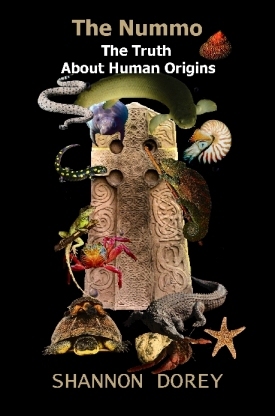
Chapter 2
Heaven's Smiths
In their ancient religion, the Dogon talked about DNA, the Big Bang, and aspects of science we are just now beginning to understand. They believed there were seven vibrations that began the universe and which were found in DNA. It was these seven vibrations that stimulated DNA to develop into a human being, a plant, or an animal. They further believed these vibrations connected all humans, plants, and animals on Earth with all other entities in the universe. It was these vibrations that became corrupted on Earth, and this was a significant part of their mythology. The Nummo experiment didn’t fail because of a simple biological problem. The mistake was so complex it was connected to the very fabric of the universe.Shannon Dorey, The Nummo. p. 19.
The Dogon believed these seven vibrations were both the soul and the life force of the universe. In Hidden Meanings, Laird Scranton relates these Dogon vibrations to what is known in physics as the theory of superstrings. According to Scranton, while the superstring theory hasn't yet been verified, it may well provide us with "the last indivisible component particle of matter…. It continues to be the most viable candidate for a unified theory of the universe."Laird Scranton Hidden Meanings, A Study of the Founding Symbols of Civilization, (Xlibris. 2002) p. 77.
In Dogon mythology, the musical octave was a metaphor for the third and final Nummo experiment. The octave is eight notes on a scale over a space of seven intervals. The Dogon believed the seven intervals, or notes, symbolized the seven vibrations, which in turn created the Eighth Ancestor identified with the eighth note. The Master (Mistress) of Speech, or Seventh Ancestor, who was the perfect combination of Nummo and human DNA, was symbolic of the seven vibrations.Shannon Dorey, The Master (Mistress) of Speech. p. 142.
In the Dogon society, these notes or vibrations were expressed through the ringing sound of the hammer striking the anvil in the smithy. The smithy was like a church, temple, or sanctuary in Dogon society, and the Smith was an important figure in the religion because the alien Nummo were said to be "Heaven's Smiths."Shannon Dorey, The Master (Mistress) of Speech. p. 116. The fire from the Nummo spaceship and the sound of the vibrations that emitted from the ship no doubt contributed to the association of the Nummo spaceship with a smithy. It was also in the smithy where humans and various implements were created.Shannon Dorey, The Master (Mistress) of Speech. p. 150.
The figure of the Smith, like the Nummo themselves, had a dual role: he was both helper and destroyer of humanity. This dual role suggests that the Smith symbolized the Nummos' interference with the Earth. This was indicated in the Dogon religion by the identification of the male Jackal with the Smith. In the guise of the Smith, the Jackal stole fire from the Nummos' workshop and fled with it back to Earth. The fire symbolized both the Nummos' spaceship and the Nummos' DNA. When he crashed the spaceship, he created fire and devastation worldwide.
The Smith was also symbolically identified with the First Ancestor, who fell in love with the Second Ancestor and destroyed the second experiment. As long as procreation was controlled, the second experiment was supposed to allow all humans to maintain their immortality. After the third experiment, it was the Smith's (First Ancestor's) responsibility to help humans find their way back to truth and immortality. The second experiment corrected the first mistake but because of the indiscretion, the experiment was considered a failure. The Nummo feared their own immortality would be jeopardized by the Ancestor's actions. At the time of the indiscretion, the Ancestors were living on the Nummos' planet somewhere in the Pleiades and the two lovers were either told to leave the Nummos' world or left on their own. Either way, they ended up back on Earth. The other Six Ancestors went with them, so all Eight Ancestors ended up returning to Earth. Once they were here, they taught those humans who had survived the initial fiery devastation caused by the Jackal.Shannon Dorey, The Master (Mistress) of Speech. p. 126.
The Smith held a separate yet prominent place in the Dogon village highlighting his importance to the religion. Only the Smith could manufacture the ritual objects, whether of wood or metal, used in religious ceremonies. Smiths, known as iru, often lived in special areas at the edge of the village, separate from the rest of the population.Shannon Dorey, The Master (Mistress) of Speech. p. 23. This probably mimicked the behaviour of the alien Nummo, who lived in their spaceships outside the perimeter of the village because of their concern the ships' fiery emissions might scorch the Dogon fields.Shannon Dorey, The Master (Mistress) of Speech. p. 23.
The importance of the Smith can be seen in the history of other places throughout the world. In these other cultures, however, only fragments of the original mythology exist, and none of these fragments explain where the myth originated or why the Smith would play such a significant role in these religions. The appearance of this character suggests that Dogon stories do indeed come from the very beginning of known history. The Greek smith god Hephaistos, the Egyptian smith god Ptah, the Egyptian moon god Thoth, and the Roman smith god Vulcan are all related to the Smith of Dogon mythology. The Smith also appears in the Celtic cultures, where Dogon symbols flourish. In the Celtic Hallstatt Culture, for instance, the Smith was identified as a dangerous wizard. According to Joseph Campbell, the Hallstatt Culture, which occupied what is now modern Germany around 900 BCE, was characterized by a gradual introduction of iron tools fashioned by a class of itinerant smiths, who in later mythic lore appear as dangerous wizards. An example can be found in the German legend of Wayland the Smith.Joseph Campbell, The Masks of God Occidental Mythology. (New York, New York. Penguin Books. 1964.) p. 292.
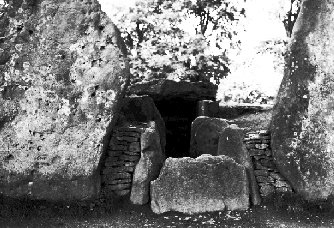 Figure 1. Wayland's Smithy ©Robert Hill |
Wayland (also Weyland, Weland, Volund, and Volundr) was the traditional Saxon god of smiths. Many places in the British Isles were associated with him, in particular Wayland's Smithy (Figure 1), a Neolithic burial chamber in Oxfordshire near Swindon and Ashbury. Saxon settlers, believing it to have been made by the smith god, named the tomb Wayland's Smithy. Later, a legend grew that Wayland would re-shoe the horse of any passing traveller who left a silver penny beside the tomb.
In 1996, unexplained crop circles depicting the Vesica Piscis were found near Wayland's Smithy. According to Peter Sorenson, the crop circles consisted of a large circle, inside of which were two crescent moons, creating the Vesica Piscis in between the shapes. In the depiction of the crop circle the two circles didn't quite touch each other, which as Sorenson points out, was very interesting. He adds that the centres were well into the standing crop, leaving no marks or damage at all to the wheat.Peter R. Sorensen Vesica Pisces http://www.partyvibe.com/ archaic/crop/1996/ashbury.html
Vesica Piscis means bladder of the fish in Latin.http://en.wikipedia.org/ wiki/Vesica_piscis It is a symbol associated with the Master (Mistress) of Speech and will be referred to in more detail in Chapter 7.
Wayland's association with the tomb is important. The fish-tailed Nummo lived underground in their spaceships. They also lived in caves and in bodies of water to prevent the sunlight from drying out their skin, which they needed to keep moist in order to stay alive. In the Dogon religion, the Nummo spaceship was synonymous with the smithy, the sanctuary, and the granary. The spaceship was the place of death and regeneration and was associated with a tomb. Ogotemmêli said that Lébé, the androgynous Eighth Ancestor, who was created during the third experiment or "third word," was regenerated in her/his own tomb.
According to John and Caitlin Matthews, Wayland was likewise associated with the world of the dead:
Wayland may also open for you the door to the Underworld, where he is a king in his own right. Wayland's Smithy in Oxfordshire has the strongest associations with him. He is almost the only Saxon deity who has remained active, assuming the roles of earlier Welsh and Irish gods. This is an indication of the special position accorded to smiths, who were the first makers and knew the mystery of iron-the origin of the folk belief that witches and faery folk cannot cross a threshold protected by 'cold iron.' Wayland shares many affinities with the ancient green king, the man of the woods, who leads to the deeper levels of lore. He is also said to have made many magical weapons, including, in all probability, Arthur's sword, Excalibur.Cailtin and John Matthews, Walkers Between the Worlds, Inner Traditions, Rochester, Vermont. 2003 p. 91
These associations of Wayland with the Green Man and Excalibur are significant. The fish-tailed Nummo were also green and in the Arthurian myths the sword was presented to Arthur by the Lady of the Lake, also known as Nimue.Cailtin and John Matthews, Walkers Between the Worlds, Inner Traditions, Rochester, Vermont. 2003 p. 87 The androgynous but primarily female Nummo were known as "Heaven's Smiths" and also resided on water, making these references about Excalibur and the Lady of the Lake relevant.
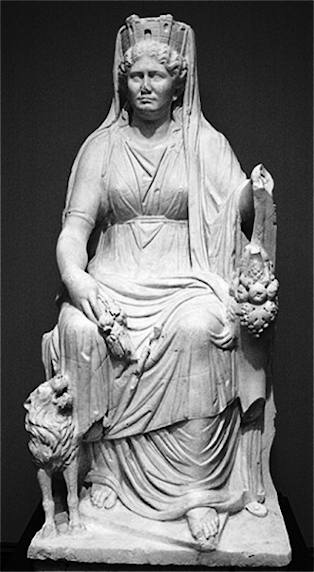 Figure 2. Cybele 50 AD, Photo by Marshall AstorCC BY-SA 2.0, https://commons.wikimedia. org/w/index.php?curid= 2294857 image reduced and cropped |
In referring to the Smith, Campbell reports the findings of Mircea Eliade who wrote that the "leading idea of the mythology was of the stone as a mother rock and the iron, the iron weapon, as her child, brought forth by the obstetric art of the forge." This was compared to the saviour Mithra, born from a rock with a sword in his hand.Campbell, The Masks of God, p. 292. According to Eisler, “the divine fish ‘Orphos or Di-orphos’, who was the son of Mithra and the Sacred Stone, was none other than a cult-symbol of the Mother Goddess Cybele, the Anatolian (modern day Turkey) Mother Goddess. She was Phrygia’s only known goddess and her cult was adopted by Greek colonists of Asia Minor, where it eventually spread to mainland Greece and distant western colonies around the 6th century BCE.
At Pessinos in Phrygia, the mother goddess — identified by the Greeks as Cybele— took the form of an unshaped stone of black meteoric iron. …Romans knew Cybele as Magna Mater (“Great Mother”), or as Magna Mater deorum Idaea (“great Idaean mother of the gods”), equivalent to the Greek title Meter Theon Idaia (“Mother of the Gods, from Mount Ida”). Rome officially adopted her cult during the Second Punic War (218 to 201 BCE). …The goddess arrived in Rome in the form of Pessinos’ black meteoric stone.
Cybele was depicted in Phrygian art of the 8th century BCE with attendant lions, which associates her with Lébé, the mother of humanity. In Figure 2-2, a marble figurine from the Getty Museum and dated to 50 CE, she is “enthroned with lion, cornucopia and mural crown.” Her processions were accompanied with wild music and she was described as being “born from stone.” Lébé was also born from stone and associated with music. According to Ovid, “when Cybele’s sacred stone was taken in procession from the Palatine temple to the Porta Capena and down the Appian Way to the stream called Almo, a tributary of the Tiber, the stone and sacred iron implements were bathed in ‘the Phrygian Manner’ by a red robed priest.” Red was the colour that symbolized the Master (Mistress) of Speech. This was because her sacrifice was associated with the sacrifice of the star Emme ya, a red giant star that once exploded to regenerate the universe. I believe it is the source of the myths relating to meteors or stones falling from heaven. I refer to this in The Rose: Dogon Star Knowledge.
According to explicit accounts given to Griaule and Dieterlen in the 1930s by informants “it was the burning mass of ‘heart’s blood’, from the sacrifice of the Nummo [Master (Mistress) of Speech]”, which hollowed out the crater of Lake Bosumtwi in Ghana, which they called the “pool of the descended anvil” el viq sugu bunnp. According to Griaule and Dieterlen, this knowledge about Lake Bosumtwi was known by all West African blacksmiths. The anvil is a female symbol and the heart was identified with the star Emme ya on the Dogon star map... “The Lake Bosumtwi impact crater is 10.5 km in diameter, slightly larger than the present lake, and is estimated to be 1.07 million years old (Pleistocene period). … According to Dieterlen, for the Ashanti, the Dogon, and the blacksmiths, the ‘sacred Ashanti Lake’ was a source of supernatural power. Dieterlen reported a list of taboos concerning the lake. It was forbidden to use metal or to have it anywhere near the lake: This included iron hooks of any description, or any kind of lure or live fishing . . . brass or metal pans (only wooden ones could be used).” Fishing in the lake was done from wooden planks…. Dieterlen referred to Rattray’s work on the Ashanti, who lived near Lake Bosumtwi. He reported about a “spirit”, which was supposed to inhabit the lake. An annual sacrifice was “offered on a sacred stone situated in the village of Abrodwum.” The Abrodwum Stone was the spiritual center of the lake.
Astarte or Ashtoreth, which is the Hellenized form of the Middle Eastern goddess Ishtar, was also identified with a meteor. She was worshipped from the Bronze Age (3300-1200 BCE) through classical antiquity.
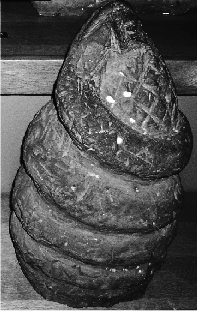 Figure 3. Omphalos Stone at Tullie House©S. Dorey |
The omphalos stones, which were referred to in detail in The Master (Mistress) of Speech, also have to do with regeneration and were associated with the Nummos’ smithy. The Nummo were identified with serpents. On many omphalos stones found in ancient Greece, Babylon, and Egypt, the serpent is seen winding around the stone like a mother protecting an egg. In some of the omphalos stones, a rodlike device rises and has ropelike strands emerging from it. At the ends of these strands appear small round, heart-shaped, or pinecone-shaped stones. This may explain how the pinecone later became a symbol of the omphalos stone. During the process when humans were created and regenerated in the omphalos stones, the individual being regenerated would be wrapped around with what the Dogon referred to as the cord of God. According to the Dogon, during the regeneration process the soul was transferred into the newly created body and the cord of God became the new body's backbone. (See Chapter 9).
The identification of the omphalos with the smithy may explain how the smithy became linked to the "obstetric art of the forge" and how the stone became associated with "mother rock." Interestingly, the label given to the Tullie House stone identified the snake with the soul and the pinecone with the symbol of life after death. This is important because it essentially means the same thing as it did in the Dogon religion: the regeneration of the dead body. The pinecone was also a symbol of the Nummo because its shape resembled a Nummo's tail. The image would thus have been further associated with immortality.
The Smith's hammer and other Dogon religious symbols also appear on Celtic Pictish stones. The Celtic Pictish religion was known to have existed as early as the first millennium. The first recorded mention of the Picts came from a Roman poem written in the third century, which refers to them as Picti or Painted Men:
Other myths detailing the origins of the Picts survive. Ninnius, writing in the early 9th century, states that they arrived from the north, landing first in Orkney and then sweeping down across much of northern Britain. Ninnius may have been confusing the Picts with the Norsemen, raided by sea down the east coast of Britain. An Irish legend states that the Picts came from Scythia, near the Black Sea, and migrated up through Europe before arriving in Ireland, where they helped the Irish against their enemies.Duncan Jones, The Picts, Goblinshead, 1998. Musselburgh, Scotland.
With the exception of a list of kings and several untranslated Ogham stones, no Pictish writings were known to have survived.J. Alexandra Nickell. The Pictish Stones of Abernethy, A Museum of Abernethy Guide. There is however an Ogham alphabet which Graves associates with the names of different trees.Robert Graves, The White Goddess,. pp. 102-103 Trees played a significant role in the Dogon religion from a practical as well as a religious perspective. Trees were related to the three "Words" or experiments in which the "Word" was used as a symbol for DNA. In Chapters 7 and 8, I equate the letters of the alphabet to genetics and the creation of genomes.
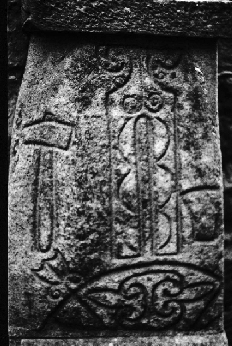 Figure 4. Abernethy Stone ©R. Hill |
The significance of sound in conjunction with the hammer and anvil can be seen on the ancient Pictish stone shown in Figure 4. There are four symbols on the stone, including the hammer and anvil. Between the hammer and anvil is a tuning fork. At the bottom is part of a crescent and a V rod, a common symbol found on other Pictish stones. The rod looks like a bent arrow with a point on one end and the fletching at the other end. What is interesting is that the bow was originally a musical instrument, which may be what this object represents. This stone was found at Abernethy Village, Scotland, at the base of a round tower that was associated with similar Celtic towers found in Ireland. It is believed that the tower was built in the late eleventh century. Abernethy was a principal seat of the Pictish kingdom.
In the Dogon religion, the arrow was identified with the Jackal and the Smith as well as with the regeneration process and with the spaceship as it made its descent. The spaceship was described as being an enormous spindle-whorl, which had served as a target for an arrow, which had been shot by the Smith as he had made his descent to Earth.Shannon Dorey, The Master (Mistress) of Speech. p. 208. On his journey through space, the Smith held an arrow in his hand. The Smith or Jackal figure was also shown on ancient boundary stones with an arrow. The Dogon word sagatara meant "powerful and strong" and designated a young man.Shannon Dorey, The Master (Mistress) of Speech. p. 23. For three weeks after the birth of a male child in the Dogon society, the mother held an arrow in her hand. It was intended to demonstrate the celestial origin of humanity.Shannon Dorey, The Master (Mistress) of Speech. p. 208. Although linguistics shows no connection between the words, I believe the word sagatara has an ancient association with the root of the word Sagittarius from the zodiac, whose glyph is an arrow. Other symbols of the zodiac as they relate to the Dogon religion are referred to in more detail in The Master (Mistress) of Speech.
A Pictish stone found at Dunfallandy also shows the hammer and anvil as well as the V rod with the crescent moon. This crescent shape with the V symbol was also later incorporated into Masonic symbols. The Masonic regalia of the fourth Earl of Rosslyn shows a V-shaped compass over a crescent,Rosslyn Chapel, Earl of Rosslyn p. 56. which looks very much like the crescent and V rod found on the Pictish stones. In the centre of the Masonic symbol is a sun, above is a five-pointed star, which are both symbols associated with the Nummo. More about the Masonic Society and its connection to the Dogon religion will be referred to in Chapter 4.
The Nummo were amphibious and didn't have human legs. Because they lived in water, they had tails, and these tails prevented them from moving very quickly over land. To help them move more quickly, they had travelling devices that looked like an iron sandal that was said to emit fire as it moved. In instances when the Nummo couldn't use their flying device, because it might scorch the Dogon fields, they were carried on the backs of humans. The Nummo were thus seen as being "crippled".Shannon Dorey, The Master (Mistress) of Speech. p. 52. Thus the characteristic of smith gods being "crippled" is an important detail, as it relates to the alien Nummo.
The smith god Wayland was associated with horses, magic, metalworking, cunning, skill, and healing. He made exquisite jewellery and according to legend, King Niduth was said to have crippled Wayland so he couldn't escape from an island where he was forced to make jewellery for the king. In time, however, Wayland made his escape by fashioning a flying device made from the feathers of birds.http://www.mysteriousbritain.co.uk /Gods&Goddesses/wayland.html The Pantheons of British Mythology. Wayland.Hephaistos, Vulcan, and Ptah, were similarly identified. Ptah was green like the Nummo and pictured with legs wrapped up like a mummy's.Shannon Dorey, The Master (Mistress) of Speech. p. 52.
Hephaistos was born "crippled" or became "crippled" after being thrown off Mount Olympus, either by Zeus or his mother, Hera.Shannon Dorey, The Master (Mistress) of Speech. p. 52. Vulcan, who was conflated with Hephaistos, was depicted on an ancient vase seated in a wheelchair type device with wings, a serpent, and a fish tail protruding out the back. Some scholars have identified the flying device as a chariot.Shannon Dorey, The Master (Mistress) of Speech. p. 106.
Graves also observed that "the lame King was frequently connected with the mysteries of the smithcraft."Robert Graves, The White Goddess, Faber and Faber, London, 1999. p. 321. The lame king was likewise associated with the sacrifice of the king referred to in detail in The Master (Mistress) of Speech. In the Dogon religion, the male Jackal was regenerated, which I believe is the basis for some of these later myths involving the death of the king. In order for regeneration to occur in the Dogon religion the individual had to die first. The genetic material from the Jackal was indirectly used in the eventual creation of Lébé, who was born as an immortal hermaphrodite. Lébé's birth signified the "third word," which was perceived as the hope for humanity. Because Lébé had a fish tail, instead of two legs like humans, she/he was considered "crippled". This was in contrast to the Jackal, who had been born with two serpent-like legs. In The Master (Mistress) of Speech, I associate the Dogon Lébé with the Greek Dionysus. Lébé was androgynous and all research seems to indicate that Dionysus may have also been androgynous and amphibious with a fish tail.
According to Graves,
Dio-nysus was usually translated as "The Light God of Mount Nyse" but more likely to mean "The Lame God of Light". Nysos was a Syracusan word for "lame"... Dionysus may really have taken his name from Nysë, Nyssa or Nysia, a name attached to various shrines in the area where the sacred lameness was cultivated.Robert Graves, The White Goddess, Faber and Faber, London, 1999. p. 321.
Lébé's regeneration occurred underground in the spaceship, which was also the smithy and the granary, because that is where the "seed" (DNA) was stored. It was associated with Lébé's grave. Marija Gimbutas also describes the regeneration of Dionysus by the Greek sun god Apollo as being associated with the omphalos and taking place underground. The Nummo were symbolized by the sun and responsible for regenerating Lébé.
"According to Orphic religion, the god Dionysus was killed and dismembered. He, like Persephone, receded into the dark depths of the earth and remained there as a seed. Women saved the seed or phallus, laid it in a winnowing fan, and performed the reawakening ritual of the god." In the myth, Zeus entrusts the limbs of Dionysus to Apollo, who sets them beside his own tripod at Delphi. The omphalos at Delphi is what marked the holy site, considered the centre of the Greek universe. It is Apollo, who is the healer and bringer of light, who eventually revitalizes the "dismembered, suffering, temporarily mad Dionysus. Each god needed the other, for they represented the complementary aspects of darkness and light. This reunification brought bliss to the Earth."Marija Gimbutas, The Living Goddesses, University of California Press, Berkeley and Los Angeles, California 1999. p. 162.
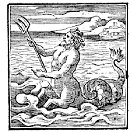 Figure 5. Proteus |
Carl Kerényi identified Dionysus with the amphibious King Proteus, said to have come from Pharos. Proteus was known as the Oracular Old Man of the Sea who lived in a cave. Proteus knew the depths of the sea and was immortal.Carl Kerényi, The Gods of the Greeks. Harmondsworth, Middlesex, Penguin Books Ltd. 1958. p.38. He was a shape shifter like Dionysus, Merlin and Llew Llaw.Robert Graves, The White Goddess, Faber and Faber, London, 1999. p. 267. The amphibious Nummo and the Eight Ancestors were also shape shifters with fish and serpent like tails. This is a picture of Proteus as he was envisioned by Jörg Breu in The Book of Emblems by Andrea Alciato (1531).http://en.wikipedia.org/wiki /File:Proteus-Alciato.gif Source, texts and description: http://www.mun.ca/ alciato/e183.html Livre d'emblèmes as Emblema CLXXXIII (emblem # 183) Because Proteus has a fish tail like Lébé and the Nummo, he would have been considered "crippled" by the Dogon people.
The lame Jacob of Genesis was connected to a cult of the Kenite smith-god and Velchanos, a Cretan cock-demon, became the Roman smith god Vulcan when his worship was introduced into Italy. In the Dogon religion, the cock was a symbol of the Dogon Jackal, who was likewise identified with the Smith. In Italy where he was identified with Hephaistos, Vulcan was said to be lame and to walk with the help of high-heeled gold shoes. Graves also refers to the winged-sandals of Hermes, Persus and Thesus. "It is likely that the eagle-wings on Hermes sandal were originally not a symbol of swiftness but a sign of the holiness of the heel, and so, paradoxically a symbol of lameness."Graves, The White Goddess pp. 321-324.
Hermes was referred to in detail in The Master (Mistress) of Speech. He is the god of thieves, which makes him a Dogon Jackal figure. Thieving is an important aspect of the Dogon religion. Hermes carried the caduceus, a symbol that looks like DNA. His winged sandals may be associated with the Nummo's device that allowed them to fly over land. The Celtic Llew was another figure identified with lameness. Llew Llaw Gyffes was known as 'the Lion with the Steady Hand'.Graves, The White Goddess p. 122.Lébé was symbolized by the lion in the Dogon religion and was perceived as being "crippled", which would associate both of Llew's characteristics with Lébé. According to Bayley,
The Welsh word llew, meaning light and also lion, is probably a corroded form of el Hu, "Lord Hu," and may certainly be equated with the Irish Sun-god Lugh…Lug, an alternative title of Lugh, is a contracted form of Lugus, the Gaulish Sun-god, and the Gaulish Lugus is what the Greeks called Logos, the divine word.Harold Bayley, The Lost Language of Symbolism, Volume II, Williams and Northgate, Great Britain, 1912. Reprinted 2007. Kessinger Publishing. p. 34.
Ogotemmêli said that Lébé was "a new Word created by two females." In the Dogon religion, the genetic experiments were identified with the "three Words". The sun was a symbol of the divine feminine. When Lébé (the Eighth Ancestor) was born she/he was mythically swallowed and then regurgitated by the Master (Mistress) of Speech (the Seventh Ancestor). This represented a union of the Seventh and Eighth Ancestors' DNA to create Lébé. Although both ancestors were androgynous, they were primarily female, which is why Lébé was said to have been a new "Word created by two females." I believe Lébé was created to offset the birth of the child from the first two ancestors. Lébé would have had the exact opposite genetic makeup of the First and Second Ancestors' child, since those ancestors were primarily male. In the Celtic version of the story, Llew's mother, Dechtire, conceived by swallowing a may-fly.Graves The White Goddess p. 305.
Even though Lébé was androgynous and associated with the sacrifice of the Jackal or in some mythologies the death of the king, she was the mother of the world. Lébé, like the other ancestors, was androgynous but five generations after Lébé's birth, humans became single-sexed and mortal beings. This was symbolically recreated in the Dogon religion through the act of circumcision. Graves describes a similar thing happening to the Celtic Llew. In the Celtic version, Llew was to become the sacred king by marriage with Blodeuwedd, the May Bride.
But he was not properly equipped for his office until he had sustained Jacob's injury which would prevent him from ever again putting his sacred heel on the ground, even by mistake.... Originally the king died violently as soon as he had coupled with the queen; as the drone dies after coupling with the queen-bee. Later, emasculation and laming were substituted for death; later still, circumcision was substituted for emasculation and the wearing of buskins for laming.Graves, The White Goddess,. pp. 321-324.
Laming became associated with the king because initially the Nummo and the Nummo Ancestors, who all had fish tails, were perceived as being "crippled". The loss of androgyny (and hence immortality) was represented in the Dogon religion through the ritual of circumcision, which is associated with the emasculation referred to by Graves in this passage. In the beginning humans had two souls, one soul which was associated with the Nummo and the other soul which was associated with the Earth. This dual soul symbolized androgyny and immortality. When the Nummo removed some of their genetic makeup from humans, it was in the form of the second sex and the second soul. I describe it in this passage in The Master (Mistress) of Speech.
The second sex was symbolized as the second soul and its eventual removal was done to help stabilize humans. The second soul was represented by the clitoris in girls and the prepuce in boys. The second soul was not completely severed after circumcision, however, but became associated with the unconscious and was the spiritual connection that humans still had with the Nummo. The identification of the clitoris in girls and the prepuce in boys with the opposite sex shows how the Dogon incorporated the concept of androgyny into single-sexed beings. Shannon Dorey, The Master (Mistress) of Speech. p. 133.
The Jackal's circumcision, which is associated with the ritual hunt tala, is an important event in the Dogon religion because it is associated with the Jackal's regeneration and will be referred to in more detail in Chapter 14.
... Softcover $31.49 USD + Shipping
EEL Publishing 2019 Fourth Edition
Pages: 405 Size: 6 x 9
ISBN: 978-0-9950405-6-4
PDF: $13.99 USD
PDF format (Read Only)
ISBN: 978-0-9950405-5-7
(Please allow 24 hours for processing)